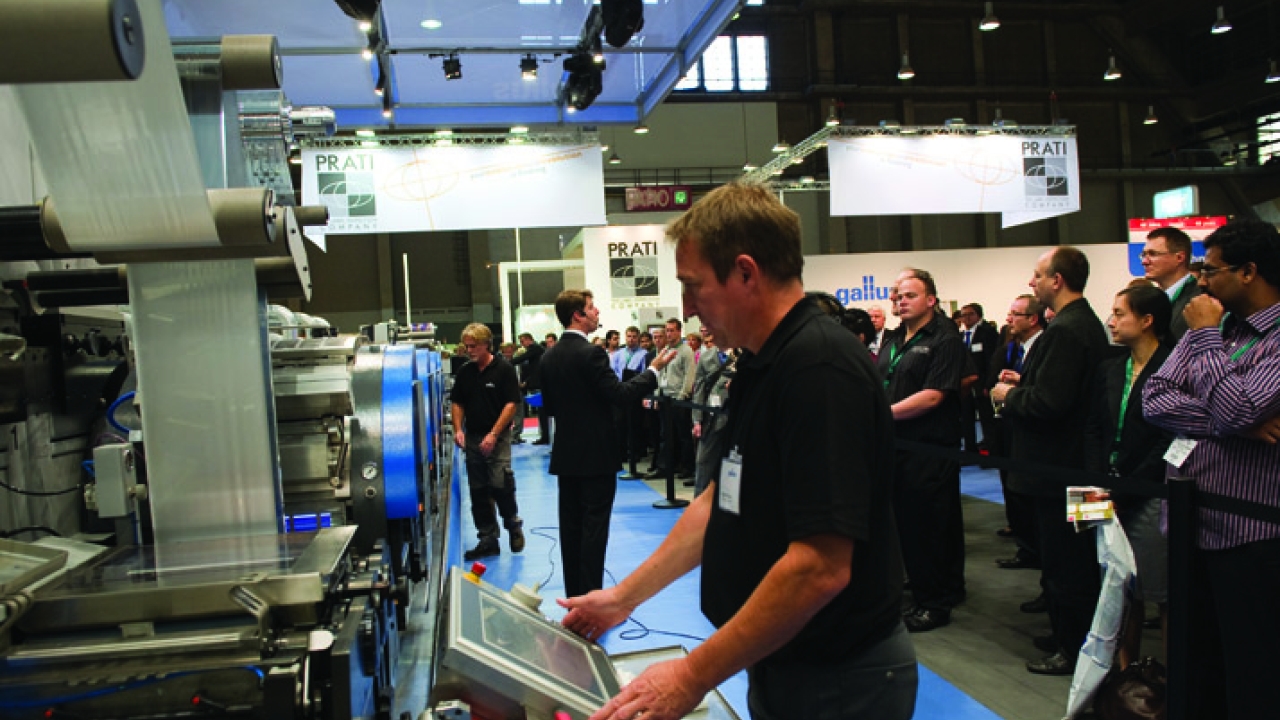Labelexpo Europe 2011 review: Short run

Barry Hunt examines how some of the latest flexo press developments are heading off any challenge from the digital sector
Several important rotary and semi-rotary offset developments were shown for some key label and packaging sectors. These will be examined in depth in a feature on offset technology in Issue 6.
Everybody was unsure about what to expect ahead of the opening of Labelexpo Europe, not least the press manufacturers. They need not have worried. The majority reported satisfactory sales levels and well-attended press demonstrations at an event just buzzing with optimism. A record-breaking attendance with visitors from all over the world helped to boost this overall impression. Many of them will remember Labelexpo as the point when many facets of digital printing came of age (see separate review).
As noted later, more digital vendors are overtly taking the fight to flexo. HP Indigo already claims to have installed more presses in the past two years than any other manufacturer. Like others, it has moved into flexible packaging and carton printing, aided by their OEM partners. Back in the analog world, single layer packaging has become more of a realistic proposition for global converters using high performance flexo or offset combination presses. As was evident in the Package Printing Zone, many growth opportunities have opened up in the markets for wrap-arounds and shrink sleeves, sachets, decorated tube laminates, also small folding cartons. Ironically, their growth mirrors end-users' demands to reduce inventories and order smaller quantities, which of course underpins the growth of digital printing within the wider printing scene.
Analog press makers have met the short-run challenge by building presses with higher levels of performance and quality compared with the types offered just a short time ago. Equipped with servo-driven functions, modern presses offer faster substrate changes, with plate and ink cylinder changeovers measured in minutes. Press demonstrations, for example, showed how certain models could quickly achieve perfect color register from idling to speeds of 150-200 m/minute.
More manufacturers have introduced shorter web paths, although not necessarily always straight ones. It is also possible with some models to print using plate cylinders with diameters of just 140mm to increase repeat sizes. A greater stress on ease of operation not only saves time, but also recognizes global variations in operator skills. All good reasons, says Mark Andy for one, why converters should wherever possible adopt modern technology because of its ability to handle a wider range of short-run jobs that once were considered as uneconomic.
The company gave the European debut of its servo-driven P5 flexo press, the more conventional P3 flexo press with direct drive train, plus the automated Genesis control system. As Performance Series presses they join the P7 introduced in Europe two years ago. It has dual servo controls and a fully-automated registration system. From high end to entry level, the three presses are designed to economically handle short runs to high quality standards. As such, the plate cylinders give repeat sizes down to 140mm to help reduce plate and ink costs. The web path design, plus advanced registration capabilities, in the series can reduce set-up waste by around 60 percent over conventional in-line flexo technologies. Set-up of a four-color job takes just under two minutes and a single station sets up in less than 30 seconds. A load-and-lock inking system, self-positioning doctor blades, easy-to-operate controls and open access are said to contribute to simple operation, regardless of skill level.
Gallus's take on the subject includes a redesigned version of the EM 430 S with an enhanced control center. The web path between print nips is halved to 2.2m to achieve faster response times when adjusting register, as well as reducing wastage. It introduced a multiweb EM 280 running with a Longford booklet insetter. As a modular press, users can replace print units with a feeder for inline booklet production, perhaps with the latest pharmaceutical directives in mind. Gallus has also boosted productivity-linked features for the two-year-old ECS 340 'granite' press for commodity labels. This rock-hard concept is at the heart of the new ECS C digital converting system. It provided the platform for the Gallus Cold Die Unit, developed with Avery Dennison for its ThinStreamTechnology. The delamination/relamination process features a PET liner as thin as 12 microns (0.48 mils), which is half the normal caliper for conventional kiss-cutting.
Nilpeter introduced some interesting productivity features for the servo-driven FB-3300S modular UV-flexo press. An eight-color version ran with the CLEANINKING anilox system with an open/close doctor blade chamber to obtain clean and easy job changes. Also fitted was Nilpeter's Revolver Die System. The 'Single Minute Exchange of Die' concept allows operators to load successive solid tooling, or magnetic flexible die plate cylinders, into the module and index them within seconds. It is also available for MO-Line offset and FA-Line flexo presses. The 570-mm wide FA-6 received its European debut, fitted with UV-curing units and hot air driers for producing film packaging, labels and carton board products. The company's hybrid approach to digital printing is described elsewhere.
New features for MPS's servo-driven EC series of flexo presses include driven chill drums and a shorter web path, backed by MPS's Crisp.Dot and a converting rail system for free positioning of units. The EC machines are built in three web widths and employ Automated Print Control (APC) which automatically sets print pressures, settings for the UV curing, corona treatment and web tension for storage in a job repeat memory. An extended APC system is integral to the latest series of EF flexo presses for producing labels, thin film packaging and small cartons in various web widths up to 508mm. They now use plate sleeves mounted on a lightweight aluminium carrier.
Short-run markets with fast changes between paper, film or foil substrates inform Omet's new XFlex X4 flexo press. Derived from the established XFlex X6, it uses similar electronic set-up and register control features with conventional plate cylinders. UV lamps mounted on the chilled impression cylinders provide short and straight web paths (145cm between units). Inline finishing includes an interchangeable hot foil module and waste-extraction unit. Also shown was a Varyflex V2 shown with an upgraded Vision-2 register control system. It now employs PC-controlled high-resolution color cameras on all print units instead of a single end-of-line head.
A highlight of Nuova Gidue's display was the new Master M5 flexo combination series, in four web widths up to 620mm. Aimed at multi-substrate production, Gidue offers a choice of print cylinders or sleeves. With an established stress on 'innovazioni', the company offers interactive links with users' MIS/JDF systems, while its so-called Digital Flexo technologies include a HD digital camera for controlling register deviation and dot gain. Another version controls print pressure and register according to the PDF/TIFF file, supported by seven servo units for each print unit. Gidue showed a new QN Coupon module producing a three-layer coupon label. Also featured was the Xpannd M7 platform press with interchangeable flexo and offset cassettes, plus hot foil and screen printing modules, using a press-side cart system.
Other interesting exhibits included Edale's new FL-350, aimed at the expanding market for fast, multi-substrate UV flexo presses. With a maximum web width of 350mm, it converts film or paper labels, tickets and packaging in a caliper range from 30 to 450 microns at up to 200 m/min. The servo-driven press incorporates Edale’s Pit Stop Colour Change for achieving changes in under two minutes per print unit. Also present was the FDC-510 flatbed die cutting machine which runs inline with existing web-fed presses for converting carton board. Edale also promoted its Lamda series of off-line converting platforms with multi-process technology.
As a dedictated packaging press, KPG's Euroflex One Press is aimed at label printers seeking to produce shrink films, small cartons, tube barrier laminates, polybags and polyamide food casings. Manufactured in Japan by ToyoKoki, it recalls the days when Ko-Pack was an influential force in press manufacturing. The Euroflex is configured with single or dual temperature-controlled central impressions drums, each with six or eight colors, and available in widths of 270mm and 400mm. It is available with UV, IR or hot air drying systems and with open or closed ink chambers.
Finally, Focus Machinery is another firm that has retained the central impression drum concept with satellite print units. Its redesigned Centraflex press now includes water-cooled UV curing lamps at each print station and a cooled CI drum for handling heat-sensitive films. It uses similar print cylinders and anilox rolls to those found on the original Centraflex presses. Focus also displayed a modular Proflex S servo-assisted flexo press equipped with an integral variable data inkjet printer from Digital Print. It uses twin Kyocera inkjet printheads with native 600 x 600dpi resolution and overlapped stitching.
Pictured: A well attended press demo on the Gallus stand
This article was published in L&L issue 5, 2011
Stay up to date
Subscribe to the free Label News newsletter and receive the latest content every week. We'll never share your email address.


